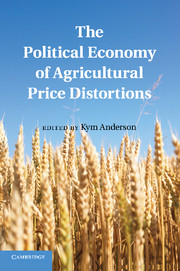Book contents
- Frontmatter
- Contents
- List of Figures
- List of Tables
- Contributors
- Foreword
- Preface
- Abbreviations and Acronyms
- PART ONE Introduction
- PART TWO CONCEPTUAL FRAMEWORKS AND HISTORICAL ORIGINS
- THREE Political Economy of Agricultural Distortions
- FOUR Special Interests versus the Public Interest in Policy Determination
- FIVE Anglo-French Trade, 1689–1899
- SIX Agricultural Protection Growth in Europe, 1870–1969
- SEVEN Determinants of United States Farm Policies
- EIGHT Agricultural Distortions in the Transition Economies of Asia and Europe
- Part Three Political Econometrics: the Past Fifty Years
- Appendix: Coverage and Distribution of Assistance across Countries and Products, 1955–2007
- Index
- References
EIGHT - Agricultural Distortions in the Transition Economies of Asia and Europe
Published online by Cambridge University Press: 05 July 2011
- Frontmatter
- Contents
- List of Figures
- List of Tables
- Contributors
- Foreword
- Preface
- Abbreviations and Acronyms
- PART ONE Introduction
- PART TWO CONCEPTUAL FRAMEWORKS AND HISTORICAL ORIGINS
- THREE Political Economy of Agricultural Distortions
- FOUR Special Interests versus the Public Interest in Policy Determination
- FIVE Anglo-French Trade, 1689–1899
- SIX Agricultural Protection Growth in Europe, 1870–1969
- SEVEN Determinants of United States Farm Policies
- EIGHT Agricultural Distortions in the Transition Economies of Asia and Europe
- Part Three Political Econometrics: the Past Fifty Years
- Appendix: Coverage and Distribution of Assistance across Countries and Products, 1955–2007
- Index
- References
Summary
Until in the late 1970s, a large share of the globe – from the center of Europe to the southeast reaches of Asia – was under Communist rule. The lives of more than 1.5 billion people were directly controlled by Communist leaders. Under this rule, agricultural incentives were massively distorted. The leaders of the Soviet Bloc and China were committed to Socialist ideology and designed their economies to be insulated from the world and its markets.
Since then, there have been dramatic changes in these countries. Yet there are large differences between these transition countries in the extent and the nature of their remaining price distortions. In 1978, China embarked on its economic reform path by introducing the household responsibility system (HRS) in agriculture. A few years later, Vietnam followed. Both countries reduced price distortions and reallocated key land rights from collective farms to rural households. In the initial years, however, market forces played little role and only became important later on. Other communist regimes did not follow this path in the 1980s. Only a series of timid reforms were tried out in the former Soviet Union during the 1970s and 1980s. However, in the 1990s, many nations of Central and Eastern Europe (CEE) and the former Soviet Union (FSU) implemented a series of bold policy reforms that often went far beyond the reforms that had been implemented in China and Vietnam.
- Type
- Chapter
- Information
- The Political Economy of Agricultural Price Distortions , pp. 191 - 212Publisher: Cambridge University PressPrint publication year: 2010
References
- 3
- Cited by



